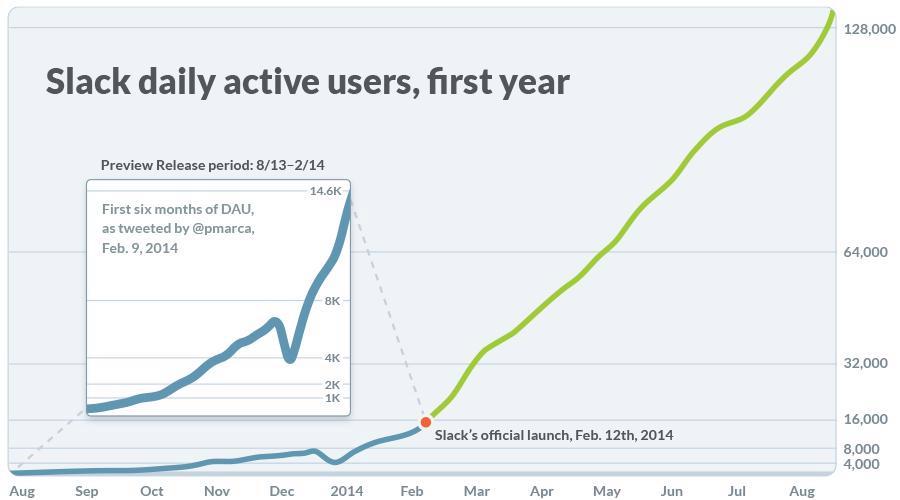The Slack Growth Strategy: 5 Key Takeaways for Your Company

Sorry, there were no results found for “”
Sorry, there were no results found for “”
Sorry, there were no results found for “”
A messaging app for teams that can boast IBM, Oracle, Target, BBC, and other Fortune 100 companies as its users without spending a fortune on marketing campaigns is worth a study.
Slack, the workplace collaboration tool, is the outcome of innovative product-market fit coupled with some unconventional marketing hacks.
While by definition, slack may mean to slow down, relax and take things easy, the company is doing anything but. Slack is one of the fastest tech startups to reach unicorn status of $1 billion in valuation in just over a year of its initial launch.
Slack was created in 2013 by Stewart Butterfield, who was then already well-known as a co-founder of the photo sharing platform Flickr that was acquired by Yahoo! in March 2005.
The enterprise messaging tool which is aimed at assisting team members to chat, work on projects together, and share links and more in real time, found an amazing product-market fit instantly and has been growing ever since.
By February 2015, when the tool was publicly available, Slack had acquired 500,000 daily active users. Within four months, this number had doubled to 1.1 million active users. Today Slack has 8 million daily active users with 3 million paid users and counting.
Slack is a great example of a powerful innovation created by accident. Something like the microwave – a device that has changed our eating habits and food market ever since it was “accidentally” invented by engineer Percy Spencer in 1945.
Founder Butterfield and his team were working on a games app called Glitch and wanted a streamlined internal communication platform. They got to work and designed the initial version of Slack to facilitate collaboration and exchange of ideas between the internal team members of Glitch. The tool soon became indispensable for the Glitch team.
So when Glitch failed to takeoff, Butterfield realized the potential of a workplace chat tool and thus Slack was born to great success.
Slack has used some innovative ways to hack its growth. Here are its top 5 strategies:
Slack proved that people still rely on the opinion of their friends or colleagues. Early on, Butterfield leveraged his contacts and connections in different companies and the press to get the word out about the new platform.
He also influenced his entrepreneur friends to give Slack a try. These connections and word-of-mouth referrals paid off, and 8,000 people signed up on Slack’s very first day. That number had almost doubled within two weeks.
Slack investor Marc Andreessen tweeted this growth chart about the company’s word of mouth growth on August 2014.

However, it is not just literal word-of-mouth. Slack also uses social tools like Twitter to reach out to a wider audience and push organic direct traffic to its website. Building buzz can benefit your product, confirming the direction of your product. At ClickUp, we’ve also seen the positive associations that come with word-of-mouth, especially on Twitter and review sites, where people offer their honest perspectives.
“We bet heavily on Twitter. Even if someone is incredibly enthusiastic about a product, literal word of mouth will only get to a handful of people — but if someone tweets about us, it can be seen by hundreds, even thousands,” says Butterfield.
Slack has over 1,000+ integrations, (including Clickup!) The company uses these integrations to gain referral traffic to its website as well as piggyback on the success of these integrations to ensure it appears on the first-page search results whenever anyone searches a product with which Slack integrates.
For instance, if anyone searches for ClickUp in Google, they will also find Clickup-Slack App Directory listed as one of the search results on Google’s first page.
Check out our list of top Slack integrations!
Slack sought continuous feedback from its early users and used it to iterate the product, its user interface, efficiency, and usefulness.
They responded to every email they received and approached every help ticket as an opportunity to improve the product or fix a problem.
The company was able to build a product that the market wanted because it listened to its users and kept track of how many people were asking for a certain feature, or a new kind of integration.
Even today, this reverence for user feedback is part of the company’s DNA.
Slack believes that every customer interaction is a marketing opportunity. If a company can go above and beyond to provide remarkable customer service, people will be delighted to recommend you. Here’s a good chance to learn what marketing is really all about!
Right from the start, Butterfield was influenced by Paul Buchheit’s thesis: If you do a few things incredibly well, the rest doesn’t really matter. And he implemented this when building Slack.
Slack did not build too many features. Instead, it focused on building one of them well. These main features were Search, File-sharing and Synchronization.
The tool’s search feature allows users to quickly find what they’re looking for, while its file sharing feature gives you the ability to drag-and-drop files, or quickly paste images through intuitive UI actions.
Most importantly, Slack has a built-in “leave-state synchronization” that allows it to know where every person in any conversation leaves off, and sync to their cursor position in real time. This single feature in itself has given them real competitive bite in a market that has seen the entry of many well-known tech giants.
Slack not only has a free plan which in itself is feature-rich, but it also operates a unique “fair billing policy.”

Here’s how it works: if a Slack user does not use the software for 14 days, Slack gives you your money back through prorated credit.
This strategy is not just useful in building great brand value. It also keeps Slack’s entire team on its toes. The team needs to continuously provide easy onboarding and comfortable user experience to add as many active users as possible.
The strategy has worked beautifully. Out of its 8 million daily active users, Slack has converted 3 million of them into paid customers.
Slack is currently valued at about $7.1 billion on the back of its latest funding round (August 2018) that saw an investment of $427 million. With the latest deal, Slack has raised total funds of $1.27 billion since inception.
Now that the firm is better capitalized it can compete better with deep-pocketed tech giants like Microsoft, Alphabet (Google’s parent company), and Facebook. Slack can also use the capital to attract and retain paying customers in a scenario where the big players have the added advantage of being able to bundle their versions of workplace collaboration services with other core offerings, enabling them to add customers at a more rapid pace compared to Slack.
Last year, investment from SoftBank Group Corp. valued Slack at $5 billion.
After last year’s fundraising round there were reports that Google, Salesforce, Microsoft, among others had shown interest in acquiring Slack.
Moreover, it was reported that e-commerce giant Amazon had held discussions with Slack about a bid that would value the workplace chat app at $9 billion valuation.
In July 2018, Slack bought the intellectual property for team collaboration platforms – HipChat and Stride – from one of its major rivals Atlassian.
As part of the deal, Atlassian will discontinue both products and encourage users to migrate to Slack.
This is an important business strategy for Slack, because, despite its current market dominance, the company is feeling competitive pressure from tech giants like Microsoft Team, Google Hangouts Chat, Workplace by Facebook and Cisco Webex Teams.
Removing a competitor sends a powerful message to the entire enterprise communication industry – that is expected to see a lot of action from new startups as well as tech giants.
With the partnership, Slack now has the opportunity to add HipChat and Stride users to its active user base. Both Stride and HipChat Cloud will be discontinued in February 2019. This is likely to boost Slack’s already impressive user base.
More importantly, the alliance with a strong and respected enterprise brand like Atlassian will give Slack the credibility to attract large corporations and financial backing necessary to hold off challenges from deep-pocketed competitors.

Slack uses some unique brand marketing techniques to turn its brand into an impressive SaaS powerhouse.
Here are 5 key growth takeaways for your business:
Provide a bigger impetus to word-of-mouth when launching the product by using traditional media. While Slack had the advantage of prior connections, you can start building your press relations from day one so that when launch day comes you have strong relationships with journalists and bloggers who would be willing to write about your product.
Pricing is a crucial aspect of a SAAS organization. Use a freemium or free trial plan to get the attention of your targeted audience.
Slack’s freemium model is ideal for people to try the app without any initial payments. You don’t need a credit card to register for the free plan. A free plan plus a super-easy onboarding process will motivate more users to give your tool a try.
Slack did not start by reaching out to CIOs or top management; they approached a team manager. If he found the product useful, the affordability of the app made it easy for him to expense it.
This can be an important strategy for your enterprise success.
There is a ton of qualitative data that your users are sharing with you every day. This is useful information that can help you tweak your product for a better product-market fit.
Slack took every opportunity to fix problems or add new features when users told them that something was not working or asked for an added service.
We also use the same approach at ClickUp. Users are invited to provide feedback and make suggestions on our feedback board.
Apart from keeping track of industry-standard numbers, you must know your company’s magic numbers that give you a clear idea of who is really using your product and how you can get them to keep using it.
For Slack, this number is 2,000 messages. Slack has observed that any team that has exchanged 2,000 messages on Slack continues to use the platform. What’s the magic number that you’re looking for that will keep your users on your platform?
Slack did not succeed because the product was unique or they had a big marketing budget. Its growth is based on listening to the customer, generating viral word-of-mouth brand awareness and developing a personable, non-salesy brand personality.
If you’re currently a Slack user, you can integrate with ClickUp to manage your tasks.
© 2025 ClickUp